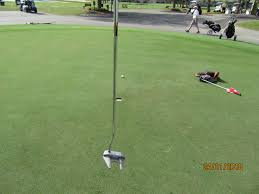Golf is a game that we all play to build our personal mental toughness. We know that we can par every hole with the perfect shots and that drives us crazy. Our goal has always been to conquer the inner demons in our minds. Unfortunately, we get caught up in too many “inner demon thoughts”. What you really need is to forget about your mental toughness and focus on our Inner Calm. Relaxing our inner calm minds will make your game happen.
Focus on the good (inner calm), not the bad and the ugly (demons).
Professional golfers have proven that their greatest success comes from an “Inner Calm” as they prepare and then hit each shot. We have all seen golfers like Tiger making a poor tee shot on the first day of a major tournament. His shots on the driving range are consistently amazing. The time from his practice to his first drive could be 15 minutes and that’s when his anxiety builds up. Occasionally a poor first drive is cause by tightness and anxiety. After that first drive, he somehow he finds his inner calm; he regains his composure and he starts hitting amazing shots.
 Overpowering your swing never generates the best results. A little less ummph is the answer. When you take a less lofted club and swing at 90% you will improve your direction and distance control. Choking down on a less lofted club and keeping your swing at 90% is also a good plan. If you plan to swing a club at a much slower swing, you will most likely impact your ball with an open face on your club and you will not finish your swing as your ball slices away from your target line. A very slow swing can mess up the physical sequence of your swing.
Overpowering your swing never generates the best results. A little less ummph is the answer. When you take a less lofted club and swing at 90% you will improve your direction and distance control. Choking down on a less lofted club and keeping your swing at 90% is also a good plan. If you plan to swing a club at a much slower swing, you will most likely impact your ball with an open face on your club and you will not finish your swing as your ball slices away from your target line. A very slow swing can mess up the physical sequence of your swing.
A very slow swing with any club can be the kiss of death as your body is not firing on all pistons. Your body gets out of sync. If you have to make a short shot with a specific club, you should setup with a more open stance to ensure that you are rotating through the ball with a full follow-through to a balanced stance. Every golf swing needs to be consistently finished with a follow-through.
Inner Calm Suggestions:
1/ Get your body loosened up with stretching and physical motion at the driving range.
2/ Hit a variety of clubs at the practice range starting with your lofted clubs and work up to your driver.
3/ Build confidence with each club by knowing the setup that allows you to hit your target.
4/ If your body is tight and you are not confident with your driver, use one of your woods for your first tee shot or even for the first few holes to get body and mind warmed up.
5/ Make a full practice swing to a balance finish at the end of your swing.
5/ Take a full inhale and exhale, as you move forward from your practice swing, to allow your tight shoulders to drop and relax.
6/ Recall that feeling of your past perfect hits or your swings at the driving range.
7/ Don’t rush your backswing and focus on completing your swing in balanced as you watch your perfect hit.
We all need to play with an inner calm mind. Understand that your best golf shots only happen when you swing with an inner calm. Practice with your GOLFSTR+ to develop perfect shots for 6 swing fixes. Mental toughness is what you want but it only comes from your inner calm. Buy one today at www.golfstr.com



